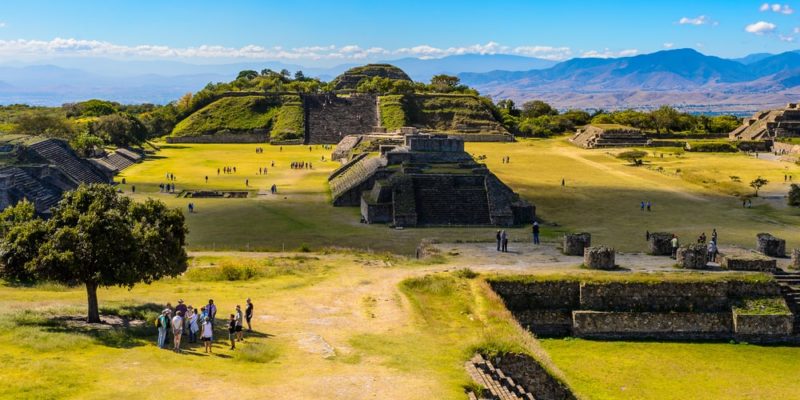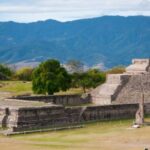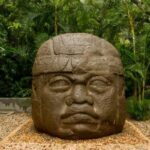We explain what the Mixtec culture was, its customs, politics and economy. Also, its contributions and characteristics.

What was the Mixtec culture?
The Mixtec culture or Mixtec civilization was one of the ancient pre-Columbian cultures mesoamerican ancestor of the current Mexican Mixtec people. It developed in the south of the current territory of Mexico, in the mountainous region known as La Mixteca. Its period of splendor was during the Postclassic period (900-1521 AD) but in the 15th century the Mixtec lordships were conquered by the Aztecs or Mexicas.
Mixtec culture He shared many traits with his Zapotec neighbors and even occupied many of the places that had belonged to this town, such as the city of Monte Albán. However, each of these cultures had their own historical path and had frequent conflicts with each other.
The decline of Mixtec culture began when the conquests of the aztec empire. The Mixtecs allied themselves with the Zapotecs to resist the Aztec advance but were finally defeated and conquered.
Other Mesoamerican cultures were: Teotihuacan culture, Toltec culture, Mayan culture, Olmec culture, Totonac culture, Zapotec culture, Aztec culture.
Key points
- The Mixtec culture was a pre-Hispanic civilization in southern Mexico that had its splendor during the Postclassic period (900-1521 AD).
- It stood out for its ceramic style, its objects made of gold and its codices written with pictograms.
- It occupied areas previously inhabited by the Zapotecs, such as the city of Monte Albán, and had cultural ties with these people.
- The Mixtecs allied with the Zapotecs to confront the Aztec Empire, but were finally conquered in the 15th century.
Location of Mixtec culture
Mixtec culture During its history it occupied the territory known as La Mixteca (Dzahui Wildebeest either Wildebeest Saviin the Mixtec language, which means “land of rain”), located in the south of Mexico, in the territory of the current states of Puebla, Oaxaca and Guerrero.
It is a mountainous region, which this culture occupied in three different areas: the Mixteca Baja (northwest of Oaxaca and southwest of Puebla), the Mixteca Alta (northeast of Guerrero and west of Oaxaca) and the Mixteca de la Costa (the Coast Girl from the states of Guerrero and Oaxaca).
Characteristics of Mixtec culture
The Mixtecs shared many traits with other Mesoamerican cultures, such as the Zapotec, Mayan, and Mexica (Aztec), including many mythological elements and their worship of certain gods, such as the solar divinity (which the Mixtecs called Yya Ndicahndíí or Taandoco).
The Mixtec religion was characterized by being animistic and polytheistic, and Its protective deity was Dzahui or Savi, personification of rain whose attributes in many ways resembled those of the god Tláloc of the Teotihuacans and Toltecs, and Cocijo of the Zapotecs. Another important deity was that of fire, Huehuetéotl, especially in the Lower Mixteca.
It is known that the Mixtecs venerated their gods with human and animal sacrifices. Their religious leaders had a hierarchical position within society, which was also fundamentally militaristic.
The Mixtecs were tenacious warriors who developed their own war strategies and their own weapons. This is evident in their ceramic art, which is preserved in abundance, and in their metal statuettes, since the Mixtecs adopted copper and gold metallurgy, although this was an activity little and late developed in Mesoamerica. There is also a record of Mixtec militarism in their codices.
The language of this culture was Mixtec derived from Proto-Mixtecan spoken in the Preclassic period. It belonged to the group of Otomangue languages and from it the Mixtec languages still spoken in southern Mexico are derived, with such a margin of diversification that the coastal variant and the mountainous one are practically different languages. The Mixtecs cultivated a pictographic writing, of which some codices are preserved.
Economy of Mixtec culture

Like most Mesoamerican peoples, the economy Mixtec was supported mostly by agriculture. Their most important crops were corn, beans, chili and pumpkin, and in regions where the climate permitted it, cocoa and non-food products such as cotton.
However, their culture constantly faced the difficulties of the mountainous relief and the scarcity of water, typical of the region, so they developed a system of cultivation on terraces called coo yuu.
They also consumed the meat of guajolotes (wild turkey) and xoloitzcuintles (wild dog), abundant in the region and domesticated by various Mesoamerican peoples. They raised cochineal, a parasitic insect of the cactus from which a pigment used to dye textiles was extracted, and they practiced occasional fishing on the Pacific coast.
Along with other Mesoamerican peoples, the Mixtecs participated in the extensive network of trade of the region and were important producers of minerals, such as magnetite. They also excelled in the manufacture of gold objects.
Politics of Mixtec culture
The Mixtec political organization was based on the establishment of kingdoms or lordships governed by an elite. Generally, the government was in the hands of a ruling lineage that entered into alliances with other important lineages and granted its military leaders the administration of war, civil and economic affairs.
One of the most important Mixtec kingdoms was the one that was founded in the 11th century under the government of Ocho Venado Garra de Jaguar, a famous chief of the Tututepec lordship on the coast, who began an expansionist process. Tututepec (Yucudzáa), Tilantongo (Ñuu Tnoo Huahi Andehui) and Ñuu Cohyo were some of the lordships unified under his command. This chief ruled them until his death.
Although sometimes they were allies and other times rivals, Mixtecs and Zapotecs had to unite to resist the incursions of the Aztec Empire in the 15th century but the Mixtecs were losing control of their cities to the Aztec troops.
For this reason, upon the arrival of the Spanish conquistadors at the beginning of the 16th century, some Mixtec lords voluntarily submitted to the command of the Spanish Crown which had ended the domination of the Aztecs.
Contributions of Mixtec culture

The Mixtecs left behind an important amount of archaeological evidence, as well as a significant contribution to the current imagination of southern Mexico. Some of these contributions were:
- ceramic production. Mixtec pottery produced abundant and striking materials, decorated with multiple colors. Ritual vessels and other ceramic objects found in various sites in La Mixteca still survive.
- The goldsmith. Despite being little developed in the region, the Mixtecs cultivated goldsmithing, especially the work of gold, which they considered excrement of the gods or waste of the sun, and which they worked using alloys, carving and hammered pieces.
- the day of the dead. Although this famous tradition of Mexican culture does not have a single origin, and combines indigenous and Catholic traditions, it is thought that the Mixtecs may have contributed to the characteristics it adopted in the Oaxaca region, either as a custom or by influence. from other towns in the region.
- The Mixtec codices. Various codices are preserved, written on deer skin, in which the genealogies of the Mixtec ruling families are detailed. This is perhaps one of the most important contributions of this culture to the Mesoamerican historical legacy.
References
- Britannica, Encyclopaedia (2011). Mixtec. Encyclopedia Britannica. https://www.britannica.com/
- López Austin, A. & López Luján, L. (2001). The indigenous past. Economic Culture Fund-El Colegio de México.
- Manzanilla, L. & López Luján, L. (coords.) (2001). Ancient History of Mexico. 4 vols. National Institute of Anthropology and History.
- von Wobeser, G. (ed.) (2014). History of Mexico. Economic Culture Fund.





